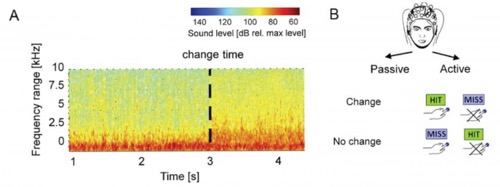Research provides insight into how the brain tunes into relevant changes in the environment.
SOCIETY FOR NEUROSCIENCE - Electrical activity in a region of the parietal cortex underlies the detection of a transition between two complex sounds, finds a study of human participants published in eNeuro. The research provides insight into how the brain tunes into relevant changes in the environment to optimize behavior.
The world is filled with a multitude of ever-changing sound. While some of these sounds signal important information about the environment, such as the presence of danger, many others are not so useful. Detecting changes in a natural soundscape is essential for identifying which sounds should be attended to.

A. We presented natural textures which change their statistics at random times to a variable degree (depicted: 3 s). The change in statistics leads to a distributed change in spectro-temporal properties. The present example shows a transition from bubbling to a linear mixture between bubbling and rain, with an intermediate mixing coefficient of 0.3. Level is relative to the maximal overall level. B. Texture sounds were provided via headphones while simultaneously recording whole-head EEG signals from 64 channels. In the active paradigm, listeners were instructed to report whether they heard a change by pressing a button after the termination of the sound and otherwise not to respond. Instead, in the passive variant they were just asked to listen to the stimuli. Image courtesy of Górska et al., eNeuro (2018).
Bernhard Englitz and colleagues presented participants with random changes (or no change) between two acoustic textures resembling rain, applause or bubbling water through headphones while their brain activity was recorded using electroencephalography. The researchers found that the longer participants were exposed to the first texture, the faster their reaction time and ability to identify the changes. Activity in the precuneus, a part of the parietal cortex near the occipital lobe, appears to be the source of these effects, which were stronger when participants were prompted to indicate whether or not they noticed a change, but also present in passive listening conditions.
###
Article: Evidence integration in natural acoustic textures during active and passive listening
DOI: https:/
About eNeuro
eNeuro, the Society for Neuroscience's new open-access journal launched in 2014, publishes rigorous neuroscience research with double-blind peer review that masks the identity of both the authors and reviewers, minimizing the potential for implicit biases. eNeuro is distinguished by a broader scope and balanced perspective achieved by publishing negative results, failure to replicate or replication studies. New research, computational neuroscience, theories and methods are also published.
About The Society for Neuroscience
The Society for Neuroscience is the world's largest organization of scientists and physicians devoted to understanding the brain and nervous system. The nonprofit organization, founded in 1969, now has nearly 37,000 members in more than 90 countries and over 130 chapters worldwide.
Source: https://www.eurekalert.org/pub_releases/2018-04/sfn-wtb040318.php

